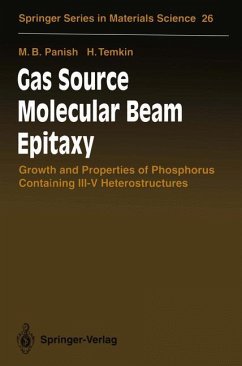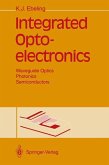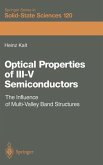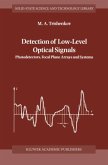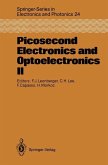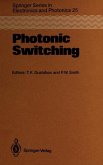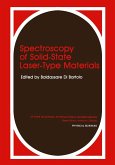Morton B. Panish, Henryk Temkin
Gas Source Molecular Beam Epitaxy
Growth and Properties of Phosphorus Containing III-V Heterostructures
Morton B. Panish, Henryk Temkin
Gas Source Molecular Beam Epitaxy
Growth and Properties of Phosphorus Containing III-V Heterostructures
- Broschiertes Buch
- Merkliste
- Auf die Merkliste
- Bewerten Bewerten
- Teilen
- Produkt teilen
- Produkterinnerung
- Produkterinnerung
Today nobody can do without modern semiconductor technology and their application in micro- and optoelectronics. Here, the technique that is able to grow thinnest and best definded layers is described by the "pope" of the method in whose laboratory it was developed. Whoever is involved in research and development or advanced studies in this fascinating field will welcome the unique volume with great interest.
Andere Kunden interessierten sich auch für
![Optical Properties of Highly Transparent Solids Optical Properties of Highly Transparent Solids]() Bernard BendowOptical Properties of Highly Transparent Solids40,99 €
Bernard BendowOptical Properties of Highly Transparent Solids40,99 €![Integrated Optoelectronics Integrated Optoelectronics]() Karl J. EbelingIntegrated Optoelectronics76,99 €
Karl J. EbelingIntegrated Optoelectronics76,99 €![Optical Properties of III-V Semiconductors Optical Properties of III-V Semiconductors]() Heinz KaltOptical Properties of III-V Semiconductors39,99 €
Heinz KaltOptical Properties of III-V Semiconductors39,99 €![Detection of Low-Level Optical Signals Detection of Low-Level Optical Signals]() M. A. TrishenkovDetection of Low-Level Optical Signals153,99 €
M. A. TrishenkovDetection of Low-Level Optical Signals153,99 €![Picosecond Electronics and Optoelectronics II Picosecond Electronics and Optoelectronics II]() Picosecond Electronics and Optoelectronics II77,99 €
Picosecond Electronics and Optoelectronics II77,99 €![Photonic Switching Photonic Switching]() Photonic Switching77,99 €
Photonic Switching77,99 €![Spectroscopy of Solid-State Laser-Type Materials Spectroscopy of Solid-State Laser-Type Materials]() Baldassare Di BartoloSpectroscopy of Solid-State Laser-Type Materials77,99 €
Baldassare Di BartoloSpectroscopy of Solid-State Laser-Type Materials77,99 €-
-
-
Today nobody can do without modern semiconductor technology and their application in micro- and optoelectronics. Here, the technique that is able to grow thinnest and best definded layers is described by the "pope" of the method in whose laboratory it was developed. Whoever is involved in research and development or advanced studies in this fascinating field will welcome the unique volume with great interest.
Produktdetails
- Produktdetails
- Springer Series in Materials Science .26
- Verlag: Springer / Springer Berlin Heidelberg / Springer, Berlin
- Artikelnr. des Verlages: 978-3-642-78129-2
- Seitenzahl: 444
- Erscheinungstermin: 30. Dezember 2011
- Englisch
- Abmessung: 235mm x 155mm x 24mm
- Gewicht: 688g
- ISBN-13: 9783642781292
- ISBN-10: 3642781292
- Artikelnr.: 36120675
- Herstellerkennzeichnung
- Springer-Verlag GmbH
- Tiergartenstr. 17
- 69121 Heidelberg
- ProductSafety@springernature.com
- Springer Series in Materials Science .26
- Verlag: Springer / Springer Berlin Heidelberg / Springer, Berlin
- Artikelnr. des Verlages: 978-3-642-78129-2
- Seitenzahl: 444
- Erscheinungstermin: 30. Dezember 2011
- Englisch
- Abmessung: 235mm x 155mm x 24mm
- Gewicht: 688g
- ISBN-13: 9783642781292
- ISBN-10: 3642781292
- Artikelnr.: 36120675
- Herstellerkennzeichnung
- Springer-Verlag GmbH
- Tiergartenstr. 17
- 69121 Heidelberg
- ProductSafety@springernature.com
1. Introduction.- 1.1 Introduction to Molecular Beam Epitaxy.- 1.2 Introduction to Gas Source Molecular Beam Epitaxy.- 1.3 Why Gas Sources?.- 1.4 Heterostructures with GSMBE.- 2. Chemistry.- 2.1 Equilibrium, the Phase Diagram, and Molecular Beam Epitaxy.- 2.2 Liquid-Solid-Vapor Relationships for the Growth of InP and GaAs.- 2.3 III-V Solid Solutions.- 2.4 Group III Metalorganics - Metalorganic MBE.- 2.5 Group V Metalorganics to Replace Arsine and Phosphine.- 3. The Generation of Atomic and Molecular Beams for Elemental and Gas Source Molecular Beam Epitaxy.- 3.1 Background.- 3.2 Molecular Effusion: The Ideal Effusion Cell.- 3.3 Real Effusion Cells.- 3.4 Gas Sources and Their Use in GSMBE.- 3.5 Introduction of the Group III Metalorganics into the MBE System.- 4. Molecular Beam Epitaxy Systems and Procedures.- 4.1 The Conventional Growth Chamber-Configuration for ESMBE, HSMBE and MOMBE.- 4.2 System Pressure - Pumping.- 4.3 Sample Introduction, Transfer and Manipulation.- 4.4 Substrate Temperature Measurement and Control.- 4.5 Gas Handling.- 4.6 Arsine and Phosphine Generators.- 4.7 Safe Handling of Arsine and Phosphine for GSMBE.- 4.8 Procedures for GSMBE.- 4.9 The RHEED Apparatus, Growth Rate and Composition Calibration.- 4.10 Metalorganic MBE Systems - Potential for Scaleup.- 5. Doping During GSMBE.- 5.1 Background.- 5.2 Maximum Free-Carrier Concentrations in Semiconductors.- 5.3 Background Doping and Carbon Incorporation.- 5.4 Doping with Tin.- 5.5 Doping with Be.- 5.6 Zn in InP and GaInAs.- 5.7 Si in GaAs, InP and GaInAs.- 5.8 Semi-insulating InP by Fe Doping During MBE.- 6. Characterization of Heterostructures by High Resolution X-ray Diffraction.- 6.1 X-Ray Diffraction of Epitaxial Layers.- 6.2 Periodic Epitaxial Semiconductor Structures.- 6.3 High-ResolutionX-Ray Diffraction.- 6.4 High-Resolution Rocking Curves of Superlattices.- 6.5 Intrinsic Strain at Heterostructure Interfaces.- 7. Optical Properties of Quantum Wells.- 7.1 Energy Levels in Quantum Wells.- 7.2 Single Quantum Wells.- 7.3 Superlattices.- 7.4 Quantum Wires and Boxes.- 7.5 Electric Field Effects.- 7.6 Strained-Layer Superlattices.- 7.7 Thermal Stability.- 8. Carrier Transport Across Quantum Wells and Superlattices.- 8.1 Experimental Techniques.- 8.2 Motion of Photo-Induced Holes.- 8.3 Sequential Screening.- 8.4 Barrier Height.- 8.5 Heterojunction Band Offsets.- 8.6 Telegraph Noise.- 9. Bipolar Transistors.- 9.1 Background.- 9.2 Figures of Merit.- 9.3 Device Fabrication.- 9.4 DC Characteristics.- 9.5 Temperature Dependence.- 9.6 Carrier Transport.- 9.7 Gain Dependence on the Base Thickness.- 9.8 Microwave Devices.- 9.9 Applications.- 10. Optoelectronic Devices.- 10.1 Broad-Area Lasers.- 10.2 Buried Heterostructure Lasers.- 10.3 Single-Frequency Lasers.- 10.4 Visible Lasers.- 10.5 Photodetectors.- 10.6 Quantum-Well Inter-sub-band Detectors.- 11. In-Situ Processing and Selective Area Epitaxy.- 11.1 Pattern Formation.- 11.2 Ion-Induced Damage.- 11.3 Towards Vacuum Lithography.- 11.4 Buried Heterostructures.- 11.5 Selective-Area Epitaxy.- References.
1. Introduction.- 1.1 Introduction to Molecular Beam Epitaxy.- 1.2 Introduction to Gas Source Molecular Beam Epitaxy.- 1.3 Why Gas Sources?.- 1.4 Heterostructures with GSMBE.- 2. Chemistry.- 2.1 Equilibrium, the Phase Diagram, and Molecular Beam Epitaxy.- 2.2 Liquid-Solid-Vapor Relationships for the Growth of InP and GaAs.- 2.3 III-V Solid Solutions.- 2.4 Group III Metalorganics - Metalorganic MBE.- 2.5 Group V Metalorganics to Replace Arsine and Phosphine.- 3. The Generation of Atomic and Molecular Beams for Elemental and Gas Source Molecular Beam Epitaxy.- 3.1 Background.- 3.2 Molecular Effusion: The Ideal Effusion Cell.- 3.3 Real Effusion Cells.- 3.4 Gas Sources and Their Use in GSMBE.- 3.5 Introduction of the Group III Metalorganics into the MBE System.- 4. Molecular Beam Epitaxy Systems and Procedures.- 4.1 The Conventional Growth Chamber-Configuration for ESMBE, HSMBE and MOMBE.- 4.2 System Pressure - Pumping.- 4.3 Sample Introduction, Transfer and Manipulation.- 4.4 Substrate Temperature Measurement and Control.- 4.5 Gas Handling.- 4.6 Arsine and Phosphine Generators.- 4.7 Safe Handling of Arsine and Phosphine for GSMBE.- 4.8 Procedures for GSMBE.- 4.9 The RHEED Apparatus, Growth Rate and Composition Calibration.- 4.10 Metalorganic MBE Systems - Potential for Scaleup.- 5. Doping During GSMBE.- 5.1 Background.- 5.2 Maximum Free-Carrier Concentrations in Semiconductors.- 5.3 Background Doping and Carbon Incorporation.- 5.4 Doping with Tin.- 5.5 Doping with Be.- 5.6 Zn in InP and GaInAs.- 5.7 Si in GaAs, InP and GaInAs.- 5.8 Semi-insulating InP by Fe Doping During MBE.- 6. Characterization of Heterostructures by High Resolution X-ray Diffraction.- 6.1 X-Ray Diffraction of Epitaxial Layers.- 6.2 Periodic Epitaxial Semiconductor Structures.- 6.3 High-ResolutionX-Ray Diffraction.- 6.4 High-Resolution Rocking Curves of Superlattices.- 6.5 Intrinsic Strain at Heterostructure Interfaces.- 7. Optical Properties of Quantum Wells.- 7.1 Energy Levels in Quantum Wells.- 7.2 Single Quantum Wells.- 7.3 Superlattices.- 7.4 Quantum Wires and Boxes.- 7.5 Electric Field Effects.- 7.6 Strained-Layer Superlattices.- 7.7 Thermal Stability.- 8. Carrier Transport Across Quantum Wells and Superlattices.- 8.1 Experimental Techniques.- 8.2 Motion of Photo-Induced Holes.- 8.3 Sequential Screening.- 8.4 Barrier Height.- 8.5 Heterojunction Band Offsets.- 8.6 Telegraph Noise.- 9. Bipolar Transistors.- 9.1 Background.- 9.2 Figures of Merit.- 9.3 Device Fabrication.- 9.4 DC Characteristics.- 9.5 Temperature Dependence.- 9.6 Carrier Transport.- 9.7 Gain Dependence on the Base Thickness.- 9.8 Microwave Devices.- 9.9 Applications.- 10. Optoelectronic Devices.- 10.1 Broad-Area Lasers.- 10.2 Buried Heterostructure Lasers.- 10.3 Single-Frequency Lasers.- 10.4 Visible Lasers.- 10.5 Photodetectors.- 10.6 Quantum-Well Inter-sub-band Detectors.- 11. In-Situ Processing and Selective Area Epitaxy.- 11.1 Pattern Formation.- 11.2 Ion-Induced Damage.- 11.3 Towards Vacuum Lithography.- 11.4 Buried Heterostructures.- 11.5 Selective-Area Epitaxy.- References.

